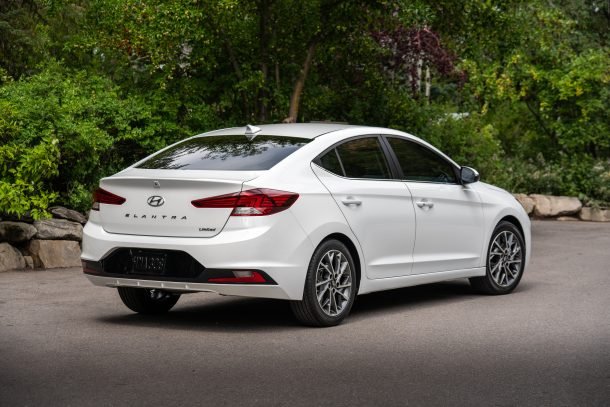2020 Hyundai Elantra Ditches the Manual, Ups the Content

Exactly a year ago, your suddenly fearful author found himself in the market for a new car. Hating the shopping experience, and with little free time, the choice soon boiled down to two scorching models: a base Chevy Cruze manual, or a similarly sparse Hyundai Elantra, also with a manual.
Twelve months later, neither vehicle exists in the United States. The Cruze is dead, and for the 2020 model year, Hyundai Motor America has decided to ditch the six-speed manual transmission, outfitting the recently updated sedan with a new continuously variable transmission.
The loss of both the six-speed manual and six-speed automatic might not please the small contingent of buyers who demand a third pedal, but it will bring a smile to the face of environmentalists and those with a deep dislike of slushboxes. Hyundai’s “Intelligent Variable Transmission” (IVT) utilizes a chain drive, improving efficiency and responsiveness over conventional CVTs. We’ll have to drive one before we can sing its praises, but the automatic Elantra offered a fast trip to Yawnville.
The difference at the pumps amounts to a 2 mpg boost, with the SE model returning 35 mpg combined. SEL, Value Edition, and Limited versions of the newest Elantra see a combined rating of 34 mpg.
Also boosted? The Elantra’s starting price. The model’s price floor rises $1,850 to a pre-destination MSRP of $18,950. Blame added standard content, which includes both the IVT and Forward Collision-Avoidance Assist, Lane Keeping Assist, and Driver Attention Warning.
Engines remain the same, with a 2.0-liter four-cylinder making 147 horsepower and a tepid 132 lb-ft of torque in entry-level guise. The Eco model remains, offering 128 horsepower and a healthier 156 lb-ft, mated to a seven-speed dual-clutch. That tranny will also be your only choice in the Elantra Sport, Hyundai’s value-priced alternative to the Honda Civic Si. The Sport’s output remains the same.
You’ll notice we specified that the stick-shift Elantra is dead in the United States, not North America. That’s because the base 2020 Elantra continues to offer a six-speed manual in Canada, with IVT optional.
As well, the entry-level “Essential” model does not don the new safety content seen on the U.S. SE trim. These two factors mean the cheapest Canadian Elantra comes in at $1,851 less than the base American model (before destination and fees), rising only $100 over the refreshed 2019 model. Information on the Elantra Sport model is not yet available for the Canadian market.
[Images: Hyundai]

More by Steph Willems
Latest Car Reviews
Read moreLatest Product Reviews
Read moreRecent Comments
- SCE to AUX Range only matters if you need more of it - just like towing capacity in trucks.I have a short-range EV and still manage to put 1000 miles/month on it, because the car is perfectly suited to my use case.There is no such thing as one-size-fits all with vehicles.
- Doug brockman There will be many many people living in apartments without dedicated charging facilities in future who will need personal vehicles to get to work and school and for whom mass transit will be an annoying inconvenience
- Jeff Self driving cars are not ready for prime time.
- Lichtronamo Watch as the non-us based automakers shift more production to Mexico in the future.
- 28-Cars-Later " Electrek recently dug around in Tesla’s online parts catalog and found that the windshield costs a whopping $1,900 to replace.To be fair, that’s around what a Mercedes S-Class or Rivian windshield costs, but the Tesla’s glass is unique because of its shape. It’s also worth noting that most insurance plans have glass replacement options that can make the repair a low- or zero-cost issue. "Now I understand why my insurance is so high despite no claims for years and about 7,500 annual miles between three cars.



































Comments
Join the conversation
FU Hyundai, you will never see my business
This article seriously lacks important product information. For example, what is the recharging time, how much is range reduced by cold weather and using the heater, and how often does this model spontaneously explode in parking garages?